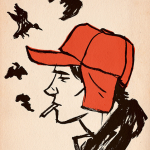Every week in The Kiddy Pool, Erin Newcomb confronts one of many issues that parents must deal with related to popular culture.
When I was about four months pregnant with my first daughter, I went running in the neighborhood where I work. It’s a mostly residential area, accustomed to pedestrian traffic from both the homeowners and the university students. To a stranger, I probably didn’t “look” pregnant at that point, but I was thrilled to be out moving in the fresh air without needing to vomit along the curb. I was less than a mile from my apartment when I realized a truck was following me, and it didn’t take long for the driver to pull up close and start shouting vulgar comments at me. In twenty years of running, I’ve had the catcalls, and I’ve been followed, but this one freaked me out a lot because, for the first time, it wasn’t just about me. I turned around to face the harasser, memorize his plates and vehicle description, and give myself more escape options; I also started screaming obscenities at the top of my lungs, intent on seeming too crazy to mess with (and, no, I can’t say if this is an officially recommended strategy). Mercifully, it worked, and I high-tailed it home with a surging flight response and a list of anxieties growing in my mind.
I knew, for instance, that the incident would never have occurred if I’d been running with my husband, who gets the occasional “Run, Forrest, Run” (so clever) but not the level of harassment that most female runners I know have experienced. I knew, also, that if the child I was carrying turned out to be a girl, I’d be responsible for a litany of precautions about safely navigating public spaces. Females simply can’t afford to think about elevators or stairwells or gas stations at night in the same way that most men can; my husband might memorize license plates while running as a mind game, but I am constantly scanning my surroundings, taking mental notes, and looking for escape routes. Seeing females run or walk with headphones makes me cringe. These are lessons that I need to teach my daughters, to be cautious and mindful, to use good judgment, and I somehow need to do that without instilling paranoia.
These lessons have been brought powerfully to my mind as I continue reading about the Trayvon Martin case. NPR’s Corey Dade writes about “The Talk” his parents gave him to prepare him for life as a black male in a racist culture. Dade references Jonathan Capehart’s Washington Post article about rules black parents set to keep their kids—especially their sons—safe: things like “don’t run in public” and “don’t run with anything in your hands”. Both of these men remind me of a piece by Brent Staples, who describes his experience being perceived as a public threat simply by virtue of being a large, black male. In “
“Just Walk on By: A Black Man Ponders His Ability to Alter Public Space,” Staples writes: “I soon gathered that being perceived as dangerous is a hazard in itself. I only needed to turn a corner into a dicey situation, or crowd some frightened, armed person in a foyer somewhere, or make an errant move after being pulled over by a policeman. Where fear and weapons meet—and they often do in urban America—there is always the possibility of death.” That line, in light of Travyon Martin’s story, is haunting.
What these writers, and their parents, share with me is awareness that public spaces are never neutral, that not everyone reads bodies or spaces the same way, and that there can be dire consequences for misreading. The onus for reading accurately lies, of course, with the one with the least privilege—the woman alone on foot or the black boy in the hoodie. But Staples complicates that message, too, in his compassionate depiction of women crossing the street to avoid him simply based on his appearance. These parental warnings and the hazy way they play out in reality underscore societal fears regarding privilege, power, and threats to social stability; they also highlight tensions between the self and the stranger, and raise fundamental questions about what it means to be someone’s neighbor.











